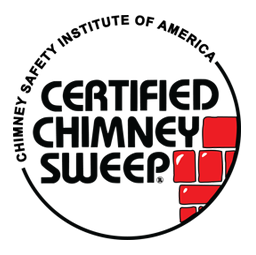Fireplace FAQ
Have a fireplace-related question? We have the answer. Check out these FAQs and give us a call today for more information!
-
How do I build a good fire in my fireplace?
Fire Building Tips for New Owners
- Have a fire extinguisher nearby.
- Open the damper completely.
- Light one piece of newspaper and hold it up to the damper, repeat this until all the smoke is exiting the chimney.
- Place starter wood or kindling on 6 rolled-up pieces of newspaper and have several other pieces of newspaper rolled up in reserve.
- Take 3 pieces of rolled-up newspaper and preheat the chimney by holding the burning paper above the starter wood, as it burns drop it on the wood.
- Cracking a window on the same level or below will help to get the fire drawing better at the start. Easterly windows usually work best, make sure you feel the cold air blowing in.
Other Important Tips for First-Time Users
- Do not use artificial logs on the first fire until step 3 above is successful.
- When you feel cold air coming down through the damper, refer to steps 3 & 6 above.
- Do not add large pieces of wood to the fire until you have established a good bed of coals.
- Do not walk away from the fire in the first 30 minutes.
- Do not put wet or unseasoned wood on the fire.
- Make sure when you add a large piece of wood to the fire, it starts to combust completely.
*Please call (781) 512-8032 if you a still struggling to build a fire*
-
What do I do if my chimney is smoking or smells?
Smelly fireplaces are a common occurrence when the weather is damp and humid, and a low-pressure system has moved into the region. These problems tend to occur in the late fall and early spring because the temperature difference between the outside air and inside air is not as great as it is in the winter.
Some solutions to this problem are:
- Making sure that your chimney is clean.
- Try to use your home’s windows to reverse the pressure coming down the chimney. The best windows to use are the ones on the windy side of the home. Basement windows are also good because they are loaded with pressure. You should crack the window a quarter of an inch, and then give it several hours to see if it makes a difference. Continue to try windows until you find the one that works best. Basically, you are relieving the pressure in your home, while bringing in fresh air.
For a guaranteed solution to these problems, you can have an Enervex chimney fan installed on your chimney.
-
What do I do if my basement fireplace is smoking?
Basement fireplaces often get smoky when the upstairs fireplace is being used. This problem is most common for homes built with exterior chimneys after the 1960s – especially in raised ranch, cape, and colonial-style homes.
This smokiness occurs when the fireplace flue in the basement is vacuuming smoke from on top of the chimney and bringing it down to the basement.
To alleviate this problem, make sure that your basement fireplace damper is closed. The best solution is to crack a window in the basement (about a quarter of an inch) when you use your upstairs fireplace. Basically, the upstairs fireplace starts searching for ‘makeup air’ as soon as you open the damper. If the basement window is cracked, the upstairs fireplace will hopefully get its ‘make-up air’ through that window, rather than the leaky damper in the basement. If you are not planning on using the fireplace in the basement, you can put a temporary seal on the top to stop the smoke from coming down the chimney and into the room.
Keep in mind that sealing dampers work about 50% of the time but are not guaranteed to solve this problem. Chimney caps can often make this problem worse. Another good option is to extend the upstairs fireplace flue tile on the top of the chimney another 12-24″.
-
Ash pits: to clean or not to clean?
We do not recommend the use of ash pits – there is a simpler way to deal with the ash.
Each year, at the end of the burning season, clear out the ash from your fireplace. To do so:
- Open the damper for the dust to rise out of the chimney.
- Make sure that there are no hot embers.
- Using several paper bags, shovel the ash into the bags and roll them closed.
- Deposit these bags into your trash.
- Leave a small amount of ash under the grate to act as an ash bed for your fire next season.
Please note: this should not be done on windy days. You can also leave this job to us. Each year, during your annual spring cleaning, we reduce our prices by 33%.
If you choose to use your ash pit you will be creating a more difficult removal process. Most often, people do not have their ash pits cleaned out until it is full, and in most cases the ash pit is the size of a telephone booth. Removing that amount of ash is time-consuming, and expensive. If you can live without an ash pit there really isn’t a reason to clean it out – and a full ash pit does not create a safety issue.
If you do call for a cleaning of the ash pit we cannot give an accurate price until we come out to your home and determine how full your ash pit is
For more info call our technical advisors Randy & Bill
(781) 512-8032





